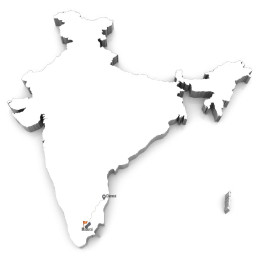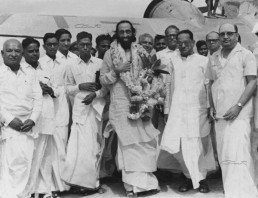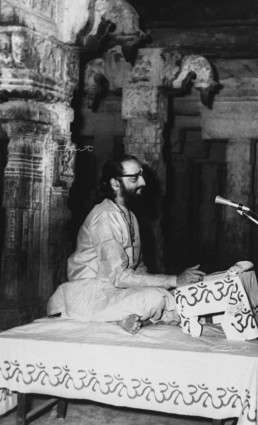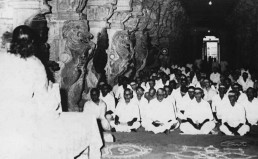
Jnana Yajna 92

Year & Dates:
August 20, 1961 to September 03, 1961

Yajna Topic:
Shrimad Bhagavad Gita- Chapter 3

Place:
Madurai, India
In Madurai, the city ruled by the Grace of Goddess Meenakshi and Lord Sundareshwara, the welcome to Pujya Gurudev was always specially warm. The large pandal near Sri Natesa Iyer Reading Room, Chinna Chokkikulam, part of Madurai, which was the venue of the previous yajna (His 62nd), was already full and filled with the rich music of the Nadaswaram.
Pujya Gurudev arrived at the yajnashala at 6:45 pm accompanied by Sri K. Balasubramania Iyer of Madras (Chennai), who was called “Dharma Rakshamani” because of championing Sanatana Dharma, and Smt, Radha Thiagarajan, the president of the yajna committee.
After the Om flag was hoisted by Sri. A. Ranganathan, a key supporter and the secretary of the previous yajna, the melodious prayer sung by Sri. V. Swaminathan, known for his devotional bhajans, provided the perfect beginning for a sacred Gita Jnana Yajna focusing on Chapter 3 of Bhagavan’s Divine Song.
The Auspicious, All-Embracing Arms
Pujya Gurudev’s discourses were like “shock therapy,” remarked Smt. Thiagarajan as she described the exceptional way Pujya Gurudev effectively removed the “delusion of modern men as even Lord Krishna removed that of Arjuna.”
Inaugurating and introducing Gita’s third chapter, the scholarly Mr. Iyer spotlighted on how Karma Yoga revealed “the philosophy of right action, viz. Nivrtti in Pravrtti.” He elaborated, “Peace and joy are his who is free from the craving for the fruits of actions. Such actions do not bind their owner; for, there is Nivrtti in his Pravrtti.” Pointing out how Pujya Gurudev exemplified this, he said: “The Swami has nothing to gain from this activity: but still he acts. as Lord Krishna Himself did in the Mahabharata war. He finds his joy even as he does his action: not at the end of his actions. This indeed is the Nivrtti in Pravrtti. And this is the essence of the third chapter of the Gita.”
Then came Pujya Gurudev’s catchy beginning: “To a modern man this audience is laughable – In the year 1961, these seemingly educated people sit down and listen to a religious discourse…here so many people sit to hear a discourse by a Swami on something a cowherd boy said to a Kshatriya some 5000 years ago!” That was because, Pujya Gurudev clarified, Gita’s chapter 3 especially taught the supreme way to channel actions for self growth through uplifting, cooperative social good.
The mornings in Madurai were sublime because of Pujya Gurudev’s classes on Mundakopanishad, and the evenings focused on Karma Yoga were unforgettable eye-openers.
A Meditation Minute:
आयामरम्यभुजदण्डगभीररूपं मायान्धकारविनिवारणभद्रदीपम्।
मुद्रादरिद्रकरुणावरुणाधिवासं श्रीचिन्मयं गुरुवरं हृदि भावयामि॥३॥
āyāmaramyabhujadaṇḍagabhīrarūpaṃ māyāndhakāravinivāraṇabhadradīpam।
mudrādaridrakaruṇāvaruṇādhivāsaṃ śrīcinmayaṃ guruvaraṃ hṛdi bhāvayāmi॥3॥
“I meditate in my heart upon Sri Chinmaya, the best of teachers, with beautiful staff-like outstretched arms and a profound form; who is the auspicious lamp that dispels the darkness of Maya and is the abode of the ocean of compassion.”
- Chinmaya Ashtakam verse 3
With a big heart and arms ready to embrace seekers of all faiths and temperaments, Pujya Gurudev transformed lives, illuminating the path to spiritual evolution. From the throes of Maya to the portals of Moksha, He pointed the way. To that benevolent and enlightening “Sri Chinmaya,” our heartfelt prostrations.
Photo Gallery

“Think,” Says Pujya Gurudev
In a dream we create a world of our own and we get ourselves identified with that world so made, and this identifier is called the dreamer. We all know that the sorrows of the dream all belong to the dreamer and to no one else. The dreamer is liberated from his pains when he ends his identification with his dream kingdom. Similarly, the actions in the world outside, which are nothing other than the vasanas existing in one’s own mind, cannot of themselves give one any attachment, but the attachment is felt by that in each one which gets itself identified with each one’s own mental condition. The moment one understands this simple fact, all one’s attachments end, and thereafter, one lives in perfect peace.
This identification with the mental condition creates the false sense of ego which arrogates to itself the idea: “I am the doer”. The doer demands the fruits of his action. To get over this attachment is to end this misconception.
From Tyagi Magazine
What is Lust?
Lust is as intense desire, extending beyond mere carnal cravings to encompass greed for wealth, power, and fame. In this video Swami Chinmayananda likens it to an insatiable glutton, compelling individuals to compromise their rationality and commit sins. And concludes with a word of caution against the destructive nature of lust, which erodes one’s moral integrity and inner peace.



